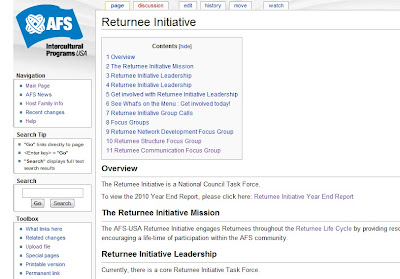Updated Observations
Since my
initial observations of AFS-USA, I have done a bit of follow-up.
The following Twitter conversation caught my eye because it reflects some confusion about the AFS-USA brand and who it serves:
AFSUSA did a good job of responding on the same day to @Batinamilk, which means AFS is both listening to and talking with the groundswell – at least on a basic level. AFS-USA’s ability to respond swiftly to Twitter questions is further exemplified in the following conversation, which gives some indication of where AFS-USA plans to go with its blog aggregator:
Another interesting development in AFS-USA’s social media strategy is its “
AFS Host Family Appreciation Award.”
The award is a badge that AFS-USA encourages its returnees to post on their host families’ Facebook walls in order to show their appreciation. This altruistic message also serves to spread the word about AFS-USA – a great example of the organization’s efforts to energize its followers.
Socialmention.com revealed that, for the last month, AFSUSA has had the following statistics:
Compared to the last snapshot from Socialmention in mid-March, strength went down by 1%, sentiment went from 49:1 to 42:0, passion decreased by 3%, and reach decreased by 16%. Overall, AFSUSA’s social media presence decreased in the past couple weeks. Though none of the decreases are detrimental, the slow decline indicates that AFS-USA is not growing in the social media world.
Conclusions and Recommendations
AFS-USA listens to, talks with, and engages the groundswell on a maintenance level. It occasionally acknowledges its Twitter followers and asks them questions, it responds promptly to concerns, and it provides various forums for prospective and current AFS students to interact and learn from each other. Its “Host Family Appreciation Award” and the Ask an AFSer Facebook group are examples of how AFS-USA is beginning to branch out to energize and embrace the groundswell further. By asking AFS students and families to take initiative in spreading the word about AFS-USA through social media, they are taking advantage of their passionate supporters. Still, in the world of social media, there is always room for improvement.
One simple improvement would be to make the
AFS blog readily accessible on AFS-USA’s main
homepage.
 |
| AFS-USA's Current Homepage - The social media links are at the bottom and the blog is nowhere to be seen! |
Also, AFS-USA’s brand awareness has some inconsistencies. So far, AFS-USA has not defined exactly what its name is in social media. Should social media users search for “AFS-USA,” “AFS USA, or “AFSUSA?” I based my searches on what yielded the most relevant results, which was AFSUSA, but the others also led to some AFS-USA-related data.
Additionally, the Facebook pages and group related to AFS-USA (
Study Abroad with AFS-USA,
Hosting with AFS-USA, and
Ask and AFSer) are not entirely consistently branded either.
Because AFS-USA is a relatively common acronym and is part of a large
umbrella organization with many different subsidiaries, some confusion is inevitable. One way to attempt to unify the brand, however, would be to brand specific social media campaigns separately and have them sponsored by AFS-USA. Study Abroad with AFS-USA, for example, could have its own corresponding Twitter account called “StudyAbroadAFSUSA”, sponsored by AFS-USA, and all blogs related to studying abroad with AFS-USA could have their own “Study Abroad with AFS-USA” blog aggregator. This could also help AFS-USA target specific sections of its broad audience. This branding strategy could extend to AFS-USA’s social media targeting of host families, parents, and especially returnees.

AFS-USA plans to reach out to returnees with its Returnee Initiative, but as of right now, it does not have much of a social media presence with AFS returnees besides its LinkedIn groups (
AFS-USA Returnee Initiative and
AFS Intercultural Program Returnees), which target an older demographic. Most user-generated content that references AFS-USA comes from people anticipating studying abroad or those who are currently abroad, not from returnees As AFS-USA forms its returnee social media outreach strategy, it should keep brand consistency in mind.
AFS-USA is actually in a good place to take risks with social media. AFSUSA’s low strength in social media could work to its advantage, because it can control and shape its brand without upsetting a large network. Most blogs, photos, and videos posted about AFS-USA are either posted by AFS-USA or are aggregated by them. Once AFS-USA feels confident about its social media brand strategy (or strategies), the organization can begin to aggressively tap into its passionate followers.
One way AFS-USA could use its followers to its advantage would be to establish a rating system for each AFS-USA study abroad program.
 |
| After following the link to each program, browsers could see immediate feedback from other people who went on the program with ratings and reviews |
When prospective students decide on programs, they essentially “shop” for their best fit. By creating a venue for returnees to rate programs and for prospective students to see those ratings as they browse their options – not unlike the rating on
Amazon.com or
ebags.com – AFS-USA would take a major step toward energizing the groundswell and allowing it to help itself. Not only would a rating system give prospective students word-of-mouth feedback they could trust, it would also re-engage returnees and give AFS-USA first-hand feedback about its programs directly from the groundswell. Yes, AFS-USA would risk negative comments and the ratings would require heavy monitoring, but isn’t that what successful social media campaigns are all about?

























